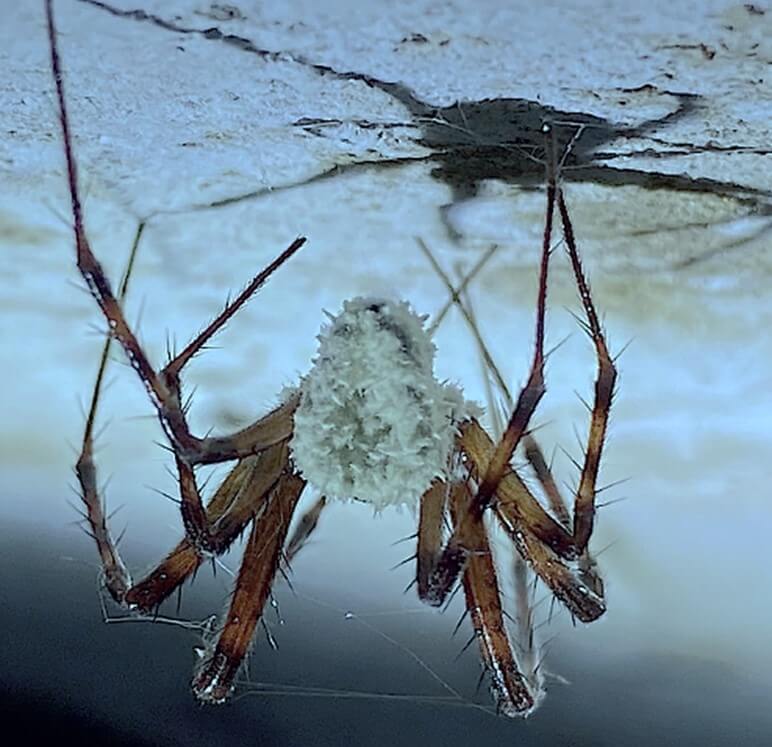

The new fungus Gibellula attenboroughii on the orb-weaving cave spider. (Credit: CABI)
WALLINGFORD, England — A new species of fungus discovered in British and Irish caves turns spiders into “zombies,” forcing them to leave their hiding spots and move into the open before killing them. Named after famed naturalist Sir David Attenborough, the fungus Gibellula attenboroughii changes spider behavior in ways that help spread its own spores throughout cave systems.
The discovery, published in Fungal Systematics and Evolution, originated during BBC’s Winterwatch television series in Northern Ireland, when an infected spider was found on the ceiling of an abandoned gunpowder store. Dr. Harry Evans, Emeritus Fellow at CAB International, led an international research team to investigate this peculiar finding. What first appeared to be a simple case of fungal infection turned out to be something far more intriguing.
The fungus affects two types of cave spiders. One spider, Metellina merianae, usually lives near cave entrances where there’s still some light. The other, Meta menardi, prefers the darker parts of caves. Both species are skilled web builders, typically remaining hidden until they need to catch prey. But when infected by the fungus, they do something very unusual: they leave their safe spots and move to exposed areas on cave walls or ceilings.
The behavior change helps the fungus spread its spores. Caves naturally have air currents that can carry these spores to new areas, and by making spiders die in open spaces, the fungus ensures its spores can travel far and wide.
This behavioral manipulation mirrors patterns seen in the famous “zombie ant fungi” of Brazil’s Atlantic rainforest, where infected ants are compelled to leave their colonies and die in positions that optimize spore dispersal. The phenomenon has captured such public interest that it inspired multiple books and even influenced popular media, including a video game and the television series “The Last of Us.”
The fungus affects each spider species differently. When infecting M. merianae, it produces elaborate, branching structures covered in specialized cells that create dense columns of spores. These spore columns appear as white to pale yellow masses under a microscope. In contrast, infections of M. menardi result in simpler structures with fewer spores, possibly an adaptation to the different airflow patterns found deeper in caves.


The discovery challenges what we know about these types of fungi. Similar fungi that control insect behavior are usually found in tropical areas, but this one thrives in cool British and Irish caves. Scientists even found over 100 infected spiders near Welsh lakes during winter, suggesting these fungi are more common in cooler climates than previously thought.
The cave system tells an even bigger story. Other fungi actually grow on top of G. attenboroughii itself, creating layers of parasites within parasites. When studied in the lab, the fungus grows slowly and changes its appearance based on lighting conditions. Specimens from completely dark areas look different from those exposed to some light, showing how the fungus adapts to its surroundings.
Looking through historical records, scientists found evidence that similar fungi have caused widespread spider deaths in Norfolk and Wales. This suggests these fungi play an important role in controlling spider populations, much like predators help control other animal populations in nature.
Scientists already know that some fungi produce chemicals similar to dopamine to control ant behavior. While they haven’t yet identified exactly how G. attenboroughii controls spiders, the consistent way infected spiders change their behavior suggests the fungus uses similar chemical tactics.
Scientists now plan to look for similar fungi in other European caves and hope to understand exactly how the fungus controls spider behavior. This could help us better understand not just how parasites control their hosts, but also how simple organisms can influence the behavior of more complex ones.
Paper Summary
Methodology
Researchers collected infected spider specimens from various cave locations across Ireland and Northern Ireland. They used both morphological examination and DNA analysis to characterize the new species. Specimens were photographed, cultured in laboratory conditions, and subjected to detailed microscopic analysis. Genetic sequencing focused on several specific regions of fungal DNA to determine the species’ evolutionary relationships.
Results
The study confirmed G. attenboroughii as a new species through both morphological and molecular evidence. The fungus showed consistent patterns of host manipulation across multiple cave systems and demonstrated distinct growth patterns depending on environmental conditions and host species. Growth experiments in laboratory conditions revealed slow but steady development of fungal structures similar to those observed in natural settings.
Study Limitations
The research was geographically limited to British and Irish cave systems, and seasonal variations in fungal prevalence weren’t fully explored. Additionally, the exact mechanism of behavioral manipulation remains unknown, as does the process by which the fungus initially infects its hosts.
Discussion and Takeaways
The discovery demonstrates that complex fungal-arthropod interactions exist even in temperate cave systems. The study also suggests that fungal diversity in these environments may be significantly underestimated. The behavioral manipulation observed adds to growing evidence that fungi can influence host behavior in sophisticated ways to enhance their own reproduction and dispersal.
Funding and Disclosures
The research was led by CAB International in collaboration with the Natural History Museum of Denmark and Royal Botanic Gardens Kew. The authors declared no conflicts of interest in their research. The discovery and initial documentation were supported by BBC’s Winterwatch series, highlighting the importance of science communication in facilitating new scientific discoveries.
Publication Information
The study “The araneopathogenic genus Gibellula (Cordycipitaceae: Hypocreales) in the British Isles, including a new zombie species on orb-weaving cave spiders (Metainae: Tetragnathidae)” was published in Fungal Systematics and Evolution, Volume 15, June 2025, pages 153-178.








